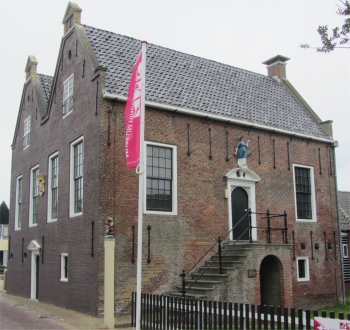
Skūtsjes by the Brabander
|
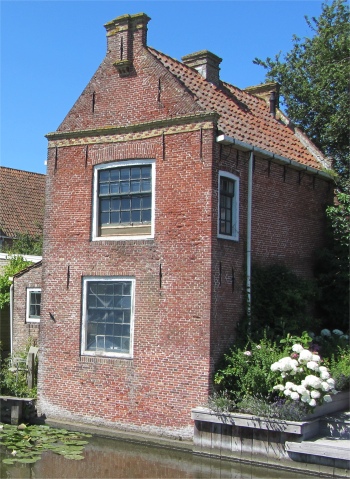
Likhus
|
By now the museum was open, so we retraced our steps a little, shared a joke or two with the lady on the till, and entered. A series of prints and paintings told us about the origin and development of the town. A short film in a "pretend" ship's cabin recounted a business trip to the Baltic Sea, allowing us to share the experience of a ship that is ready to leave for St. Petersburg. We were also introduced to Hindelooper painting through a fully furnished house, which included beautiful painted furniture, colourful costumes, jewellery, paintings and other treasures from the 18th century.
Walking down a small alley we stumbled across a delightful, little, canal-side cafe with a handsome boat moored in front of it; a lovely place to rest and sip coffee. No sooner had we sat down than a quorum of local council men started to attack foliage with noisy chain saws just opposite us. Rex went into Victor Meldrew mode with gusto, and cursed fluently in several languages including blue. Hey ho, such is life, we outlasted them and eventually enjoyed some peace and quiet.
I checked out a small canal-side gallery nearby, full of abstract geometric 3D works of art. I pondered on the content for a while, the geometric aspects intriguing me, and asked the artist if he had been an engineer. "No," he replied, "but I was a graphic designer. Now I am retired and just create when I feel like it." I stared at one picture, and thought I could make out a group of skaters. "No, they are footballers," he told me. "My son used to play football when he was eight years old. One of the boys used to just stand and look down at the grass all the time, and he is that one there," he added, pointing out one of the abstract figure representations on his art piece. I took his word for it, but I would never have worked out that little gem in a million years. I thanked the man for allowing me to look around his gallery, and left more confused than when I went in.
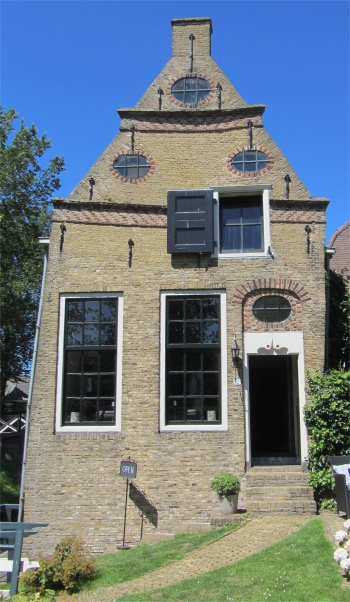
Sea Captain's House
|
Moving on we came across the Frisian Skating Museum. I understood the museum itself contained a large collection of skates, slides, old prints and an Elfsteden history with many photos. We decided not to enter, but the shop that fronted it was a treasure house full of painted clogs (Klompen), trays and bric-a-brac; spell-binding.
Crossing a canal via a small bridge, we found ourselves adjacent to the town football field, and started walking alongside the canal. Opposite, on the other side of the canal, a few wonderful, small, old brick buildings stood on the water's edge, accompanied by stunning gardens and hideaways, where the owners could sit in comfort around a table overlooking the canal. Now in bygone times of glory, the small streets contained sea captains' houses, and it is still possible to see an anchor hanging on the faēades of these houses, in those years a sign that the captain could still accept freight. In summertime when the captain was at sea, the captain's wife lived with the children in the so-called "Likhus", a little house behind the captain's house at the waterline. It was a group of such Likhus that we were admiring.
The canal abruptly turned left and widened out. It was here that Rex did his good deed of the day by helping out a boat tie up to the bank; he was really taking yet another opportunity to polish up his linguistic skills. We followed the wide canal down, it seemed to mark the town boundary. On the opposite bank large expensive looking properties stood with their attendant manicured gardens. To our left, fields stretched away, some containing cattle, others horses. A road bridge allowed us to cross the canal. From the bridge we could see the canal disappearing off into the countryside, and a train winding its way across the fields to Hindeloopen station and Workum.
We carried down along the road to the dyke overlooking the Ijsselmeer. Climbing the dyke, we were presented with a magnificent panorama of kite surfers and wind surfers, all skimming across the shallow waters near the shore. How they avoided tangling each other's lines I'll never know. We took the scene in for a while before we walked along the dyke and returned to the town, only to discover another little treasure.

Pancake Cafe
|
This was at one time a 17th century sea captain's house. We entered the house and a charming lady showed us around, pointing out the tiles on the wall, the top half being shades of white, the bottom half containing tiles of jumping creatures such as dogs, cats and rabbits. "The higher the picture tiles reached, the greater the prosperity of the owner," she explained. Above a couple of wall cabinets was a frieze of hand painted floral designs, which had been imported from Italy in the 17th century.
On one side of the cabinets she opened a door, and took us down to a room which was a kitchen and larder area. Again tiles decorated the walls, and a tiled projection from a corner in the ceiling indicated where an oven had once stood below. The kitchen also contained pristine white melamine fittings, it was obviously being utilised. "I live here," she told me. The larder had a small vertical opening to the outside through which a cool draft wafted. The walls of the building were very thick, and she explained that unless there was good ventilation, its interior would become unbearably hot.
The other door next to the cabinets lead us up to another room, almost like a studio. It was here that we learned the woman was an artist, and several of her works hung on the walls or lay on the table. She also talked us through some photographs, and one photo displayed a Likhus we had seen earlier. She informed us what the Likhus was, and that the family would move to this smaller dwelling while the captain was away. "But why?" was the obvious question. "Because there is less to keep clean in a smaller house," she explained. My mind momentarily flipped to images we had encountered of the Dutch obsessively cleaning anything made of atoms.
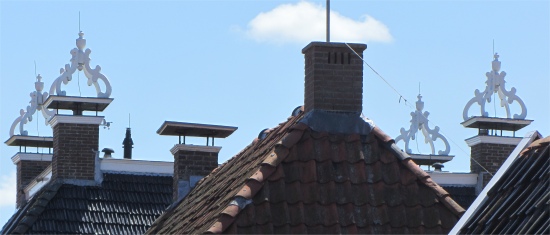
Roof Top
|
We thanked the lady and made our way back to the boat. As we arrived at the marina we noticed a large yacht being towed out by a small motorboat, the marina work boat as it turned out. Rex commented, "That's the large yacht we saw this morning slung underneath the crane, the one with the retractable bow thruster." The large yacht suddenly juddered to a halt as its keel hit a patch of sand, but the small tow craft managed to free it, and off it slid out into the narrow channel leading to the Ijsselmeer. Did the yacht's engines no longer work, we'll never know. A short distance down the channel the motorboat and yacht ran into more difficulties, effectively blocking the channel. Other boats entering or leaving the marina had to weave their way around the floundering yacht. We couldn't make out what the problem was, but the stricken craft was a definite hazard. By now a small crowd had gathered to observe the proceedings. Then we spotted activity around a rescue boat. Its engines started up, but the crew were not frantic. They dawdled up to a hut and eventually dawdled out in their wet weather gear. After an age they were all on their rescue boat, but nothing much was happening. Were they all muttering, "We cannot leave until we have cleaned our boat."? It was just as well the occasion was non-life threatening. Eventually the vessel reversed out of its pen and slowly edged out into the channel. It seemed to circle the wallowing yacht for ages before a tow rope was attached. Meanwhile another rescue boat was launched. The last we saw of the incident, the stricken yacht was being towed down the channel at almost snail pace. Perhaps the vessel was going to journey on under sail, and it required much deeper water before the sails could be raised.
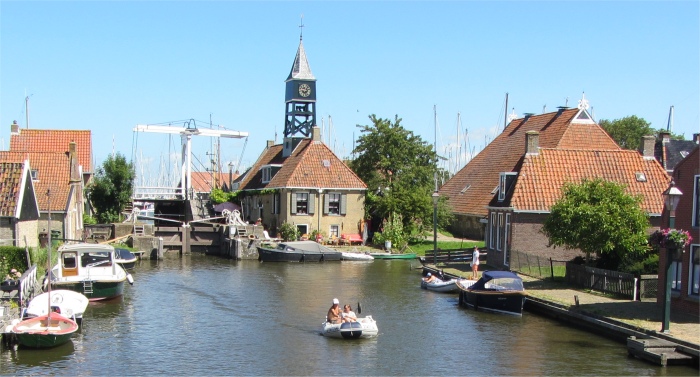
Looking Towards the Sylhuis Lock
|
Whilst on
Duonita, a Dutch boat entered the box beside us. It was a chartered yacht, crewed by the Dutch couple Ronald and Minki, and their two young sons. The couple didn't own a boat, and Ronald often crewed for family members and friends, and this was the first time they had chartered. They had just sailed over from Medemblik (the winds had abated sufficiently by now). The boys immediately popped off to swim in the complex's swimming pool. As soon as they had gone, out popped a cage containing a canary, which the couple hung on the end of the boom. We had a long and pleasant chat with the couple. Minki grew up in Hindeloopen, and when she met her husband at university, she had taught him to sail. Stories of sailing trips were exchanged, and our knowledge of Friesland and the Netherlands was extended.
We were also told the name of what they regarded to be the best pub in the town, the
Brabander. By pure chance this was the same place where Rex and I had coffee earlier by the canal, with the beautiful boat in front of it. Minki explained that the boat was a skūtsje, a flat bottomed Frisian sailing boat of the type tjalk, originally an ordinary cargo boat, but today a prized ship and one of the icons of Frisia. Skūtsjes were built from the 18th century until about 1930 and are 12 to 20 m long and on average 3.5 m wide. In the 1920s and 1930s many skūtsjes were fitted with engines and after World War II the sails were even often removed. Nevertheless other, much larger, powered boats took over water transportation in the area and many skūtsjes were rebuilt into houseboats or luxurious sailing yachts. Over time, more and more were restored to their original state. There is a yearly racing event in Friesland called Skūtsjesilen. Such races were already held in the early 19th century, but since 1945 they have been regulated through a committee, SKS. In these races, each skūtsje represents a city or village. This racing started early in the 20th century where villages in Friesland, or more precisely often the bar and hotel owners, made prizes available for the winner. At that time the skipper and his family lived on board in a narrow cabin, and before the race, the family and the interior of the cabin was placed ashore to make the boat as light as possible at the start of the race. "This Saturday they will all be racing down at Stavoren," Ronald told us. All the time the small canary chirped away, no doubt pleased to be out in the fresh air.



